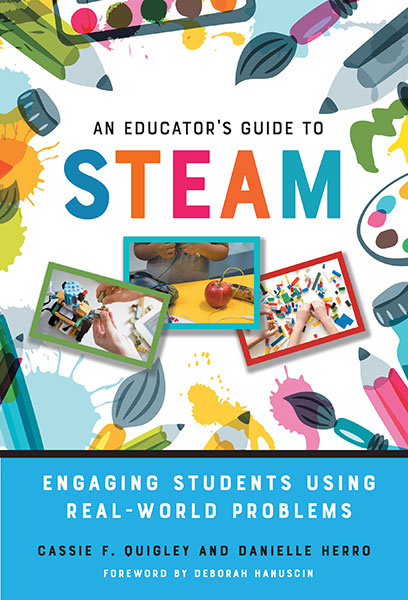Professors: Request an Exam Copy
Print copies available for US orders only. For orders outside the US, see our international distributors.
Cassie F. Quigley, Danielle Herro
Foreword by: Deborah Hanuscin
Publication Date: March 29, 2019
Pages: 168

This practical book will help readers understand what STEAM is, how it differs from STEM, and how it can be used to engage students in K–8 classrooms.
The authors present a conceptual model with recommendations and classroom examples illustrating various key aspects of STEAM teaching in action, including creating the correct teaching environment, integrating STEAM content, and supporting students as they develop STEAM-related skills. The model includes specific strategies such as problem-based learning, student choice, technology integration, and teacher facilitation. Each chapter incorporates elements of connected learning—a type of learning that draws on students’ interests that teachers can capitalize on when using STEAM to address real-world problems.
Readers will find easy-to-understand examples of what STEAM education looks like in a variety of classrooms, and will hear from teachers, instructional coaches, principals, and administrators about what it takes to ensure that STEAM is a schoolwide success.
Book Features:
Cassie F. Quigley is an associate professor of science education at the University of Pittsburgh. Danielle Herro is an associate professor of digital media and learning at Clemson University.
“This book provides a well-realized conceptual framework for various stakeholders who are interested in successful implementation of STEAM education in K-12 public schools. The framework and suggestions are grounded in evidence from the authors’ sustained partnerships and fieldwork in STEAM. This book will be a valuable resource for all who are interested in learning more about STEAM and implementing it in their own schools and districts.”
—Teachers College Record
“As a teacher, and now teacher educator, I understand the complexity of teaching and the difficulty of enacting change in one’s practice—such as shifting to STEAM teaching. The authors of this book do due diligence in unpacking this complexity and discussing specific barriers teachers and schools might face in this undertaking. More importantly, they provide inspiration to sustain readers through this challenging work by emphasizing the rewards for both students and educators who engage in STEAM education.”
—From the Foreword by Deborah Hanuscin, Western Washington University
“The authors do a wonderful job of unraveling what STEAM actually is and what it is not. This text will be appreciated by school and district staff interested in implementing STEAM education for students. The book provides wonderful real-life examples of implementation strategies and clarification on the many misconceptions of STEAM instruction.”
— Kevin O’Gorman, chief academic officer, Berkeley County School District, South Carolina
“An Educator's Guide to STEAM will become a go-to for crafting meaningful STEAM learning experiences for students. The STEAM conceptual model grounded in principles of Connected Learning is useful and approachable, all while tying back to research. Quigley and Herro thoughtfully address the need for district-level support and visioning for STEAM education, which is often forgotten. Among the greatest strengths of this guide are all of the examples from real classrooms and schools, across grade levels and school contexts.”
—Nicole Beeman-Cadwallader, senior director of curriculum and design, National Math and Science Initiative
Contents
Foreword by Debi Hanuscin
Acknowledgments
Introduction: Grounding Our STEAM Work
Our Entry into STEAM Education
An Example of STEAM in Action
The Purpose and Usefulness of This Book
The Organization of the Book
PART I: CONCEPTUALIZING STEAM
Chapter 1. Unpacking the Conceptual Model to Guide STEAM Teaching
STEAM: Understanding the Rising Trend
Exploring the STEAM Conceptual Model
Examining the STEAM Conceptual Model Across Grade Levels
Concluding Thoughts on the STEAM Conceptual Model
Chapter 2. Visioning, Planning, and Supporting STEAM Instruction in Schools
Visioning STEAM
Understanding and Defining STEAM
Building a Foundation for STEAM
Visioning and Planning Across Grade Levels
Concluding Thoughts: Common Questions and Answers About Transitioning to STEAM Education
Chapter 3. Making STEAM Relevant to Students
Exploring Ms. Andrus's Classroom
Designing a STEAM Unit Around Interests
Creating STEAM Problem Scenarios
Involving the Community: Broadening Participation Through Mentors and Experts
Making STEAM Relevant Across the Grade Levels
Concluding Thoughts on Making STEAM Relevant
PART II: DEVELOPING STEAM CLASSROOMS
Chapter 4. Understanding the Role of Teaching Across the Disciplines in STEAM Teaching
Transdisciplinary Teaching and Learning
Transdisciplinary Teaching in Action
Connection to Components of the STEAM Conceptual Model
Authentic Discipline Integration
Connection to Authentic Tasks
A Pathway for Multiple Methods to Solve the Problem
Strategies to Support Transdisciplinary Teaching
Transdisciplinary Teaching Across the Grade Levels
Concluding Thoughts on Transdisciplinary Teaching
Chapter 5. Valuing the A in STEAM
The Continuum of Arts Integration
The Value of Art in STEAM
Art as the Backbone of Problem Solving
Integration of Arts Across Grade Levels
Concluding Thoughts on the A in STEAM
PART III: MAKING STEAM WORK
Chapter 6. How to Assess STEAM Learning
A Different Approach to Assessment
Embedded Formative Assessment
Authentic Summative Assessments
Peer and Self-Assessment in STEAM
STEAM Assessments Across Grade Levels
Concluding Thoughts on STEAM Assessment
Chapter 7. STEAM Across Different School Settings
Context One: A New STEAM School
Context Two: A Traditional Middle School
Context Three: An Existing School Transitioning to STEAM
The Key to STEAM Implementation: Remixing Education
Supporting STEAM Across Grade Levels
Concluding Thoughts on STEAM Implementation in Different Settings
Chapter 8. Challenges to STEAM Instruction
The Nature of Challenges with STEAM Education
Solutions for STEAM Instructional Challenges
Concluding Thoughts on Challenges in STEAM
The Future of STEAM: A New Beginning for Educators?
Revisiting STEAM Versus STEM
Recognizing the Necessity of STEAM
Moving Forward with STEAM Education
Final Thoughts
References
Index
About the Authors
Professors: Request an Exam Copy
Print copies available for US orders only. For orders outside the US, see our international distributors.